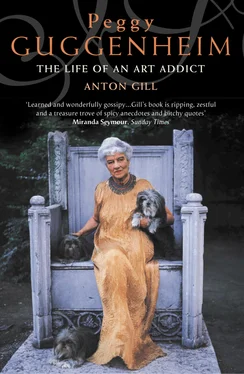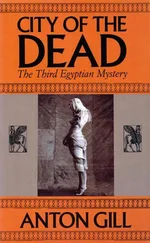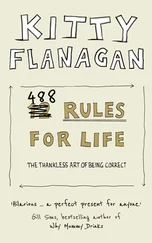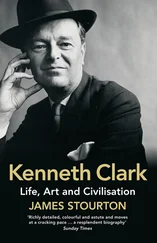En route to Capri, the newlyweds stopped in Rome, where Peggy’s cousin Harold Loeb was running his magazine Broom. Laurence had already published one or two pieces in it, and Harold now asked him for a poem. Laurence had already taken against the Guggenheim family, specifically the brothers who controlled the family firm, and was to remark that he would happily throw them all over a cliff. His dislike was probably prompted by the fact that Peggy’s capital was carefully protected; but it found an outlet in the poem he submitted:
Old men and little birdsToo early in the morningMake squeaks.
Little birds are more brazen;Primly, they dip their feet in puddles.Old men have delicate feet.
Old men have delicate bowels,Little birds are careless,Near love of neitherIs sweet.
Little birds chirp, chirp, chirp, chirup;Old men tell stories, tell stories;Both die too late.
When the piece appeared in the September 1922 edition of Broom , it provoked a querulous reaction from Peggy’s cousin Edmond. Loeb calmed him down, but Laurence felt a flicker of grim satisfaction.
Peggy and Laurence, bare-legged and besandaled to underline their contempt for anything bourgeois, proceeded on their expensive honeymoon. Privately, Peggy continued to nurse her sexual and personal disaffection with marriage; but at least getting married had achieved one goal for both of them: independence from their families.
Capri in the early 1920s was a beautiful and still isolated place, a resort for the rich and the eccentric. Here a young French nobleman consorted with the goatherd he had adopted as his boyfriend, had educated, and introduced to opium; here lived the German industrialist Gustav Krupp von Bohlen und Halbach in a magnificent mansion; and here too, more modestly, lived the Compton Mackenzies. An old lady, reputed to have been the lover of a former Queen of Sweden, sold coral in the streets; and during the season before Peggy’s arrival Luisa Casati, an exotic figure who became the mistress of the poet, womaniser and war hero Gabriele d’Annunzio, had wandered the island in the company of a pet leopard. Casati owned a palace in Venice, the Palazzo Venier dei Leoni, which thirty years later would become Peggy’s final home.
Despite the exotic nature of the place, Peggy didn’t enjoy it much, since her style was cramped by the presence of Clotilde. If Laurence’s mother had accepted Peggy – though Peggy was never allowed to address her as anything other than ‘Mrs Vail’ – Clotilde was not going to relinquish one iota of her hold over her brother. It was humiliating to be treated as the unwelcome third person on one’s own honeymoon, and as Peggy put it, ‘[Clotilde] always made me feel that I had stepped by mistake into a room that had long since been occupied by another tenant, and that I should either hide in a corner or back out politely.’ Peggy also, despite her own ambitions in that direction, found her sister-in-law’s libertinage shocking. She was also envious of it. To make matters worse, Clotilde’s lovers drove Laurence into a jealous frenzy. Clotilde was three or four years older than Peggy, more attractive and more worldly. She delighted in making Peggy feel inferior, but resented Peggy’s wealth. Peggy quickly came to realise what a weapon her money was.
She had enough obduracy not to let herself be undermined by the Vails’ snobbery and anti-Semitism. At the end of the summer they left Capri, travelling to St Moritz via Arezzo, San Sepolcro, Venice, Florence and Milan. By then the two sisters-in-law seem to have come to some kind of accommodation. Laurence and Peggy played tennis together so well that they won a tournament, and they seemed, if not passionately in love, at least genuinely fond of one another. Nevertheless, when the autumn came, Peggy left for New York for a long-arranged visit to Benita, while Laurence took Clotilde off on a tour of the Pays-Basque on a motorbike which Benita had given him as a wedding present.
In New York, Peggy arranged for the publication of Laurence’s short work Piri and I , and had an enjoyable time with her sister despite the jealousy she still felt for Benita’s husband.
Before she returned to Europe and her own husband, she discovered that she was pregnant.
CHAPTER 8 Laurence, Motherhood and ‘Bohemia’
At the end of 1922 Peggy returned to Europe with her Aunt Irene. Laurence was at Southampton to meet the ship. The couple were delighted to see one another again, and Laurence behaved himself right through a visit to Peggy’s cousin Eleanor in Sussex, where she lived with her cattle-farmer husband, the Earl Castle Stewart. But the Vails were an ill-matched pair, and no sooner were they back in Paris than they began to quarrel. Laurence had boundless energy and great, if misused, intelligence. He would invite anyone he met on the street, including whores and clochards , to parties, he would spend up to three days on binges, and he was deeply frustrated by Peggy’s apparently placid nature.
Peggy, however, knew exactly how to provoke him, and frequently did so. She was still in touch with her former teacher Jacques Schiffrin, and had advanced him money to help set up his imprint Les éditions de la Pléiade. When she told Laurence she was in love with Schiffrin he went berserk, smashing an inkpot and the telephone in their suite in the Hôtel Lutétia, where they were living. The splattered ink ruined the wallpaper, which had to be replaced, and Peggy had to engage a man to remove ink from the carpets and floors, which took weeks. There is nevertheless a hint of enjoyment in Peggy’s recounting of the story, as if this were all part and parcel of the anarchic, artistic life she believed she was living. And she retaliated in a way which was calculated to stir up Laurence further, by reminding him that it was she who held the purse-strings. Through that she controlled the relationship. Laurence was too weak to break free, and revenged himself for his humiliation by harping on Peggy’s lack of finesse, education and sophistication. In fact Peggy, a natural autodidact, was continuing to educate herself through the artists and writers she came into contact with, though it was a slow process, and her real relationship with the artistic life of Paris was not to come until much later.
Peggy had an acute perception of both the situation and her husband’s character:
Laurence was very violent and he liked to show off. He was an exhibitionist, so that most of his scenes were made in public. He also enjoyed breaking up everything in the house. He particularly liked throwing my shoes out of the window, breaking crockery and smashing mirrors and attacking chandeliers. Fights went on for hours, sometimes days, once even for two weeks. I should have fought back. He wanted me to, but all I did was weep. That annoyed him more than anything. When our fights worked up to a grand finale he would rub jam in my hair. But what I hated most was being knocked down in the streets, or having things thrown in restaurants. Once he held me down under water in the bathtub until I felt I was going to drown. I am sure I was very irritating but Laurence was used to making scenes, and he had had Clotilde as an audience for years. She always reacted immediately if there was going to be a fight. She got nervous and frightened, and that was what Laurence wanted. Someone should have told him not to be such an ass. Djuna tried it once in Weber’s restaurant and it worked like magic. He immediately renounced the grand act he was about to put on.
These tantrums often got Laurence into trouble with the police, but it was a mania that stayed with him for most of his life. In 1951 he got into a row in the dining room of the Hotel Continental in Milan with a friend of Peggy, Carla Mazzoli. As Maurice Cardiff, who knew Peggy and was there at the time, remembers: ‘When he had worked himself into what seemed a simulated rather than genuine frenzy, he left the table to return with a pot of jam he had taken from the restaurant kitchen. Dipping his finger into the pot he tried, unsuccessfully, for we all intervened, to rub the jam into Carla’s hair.’
Читать дальше












